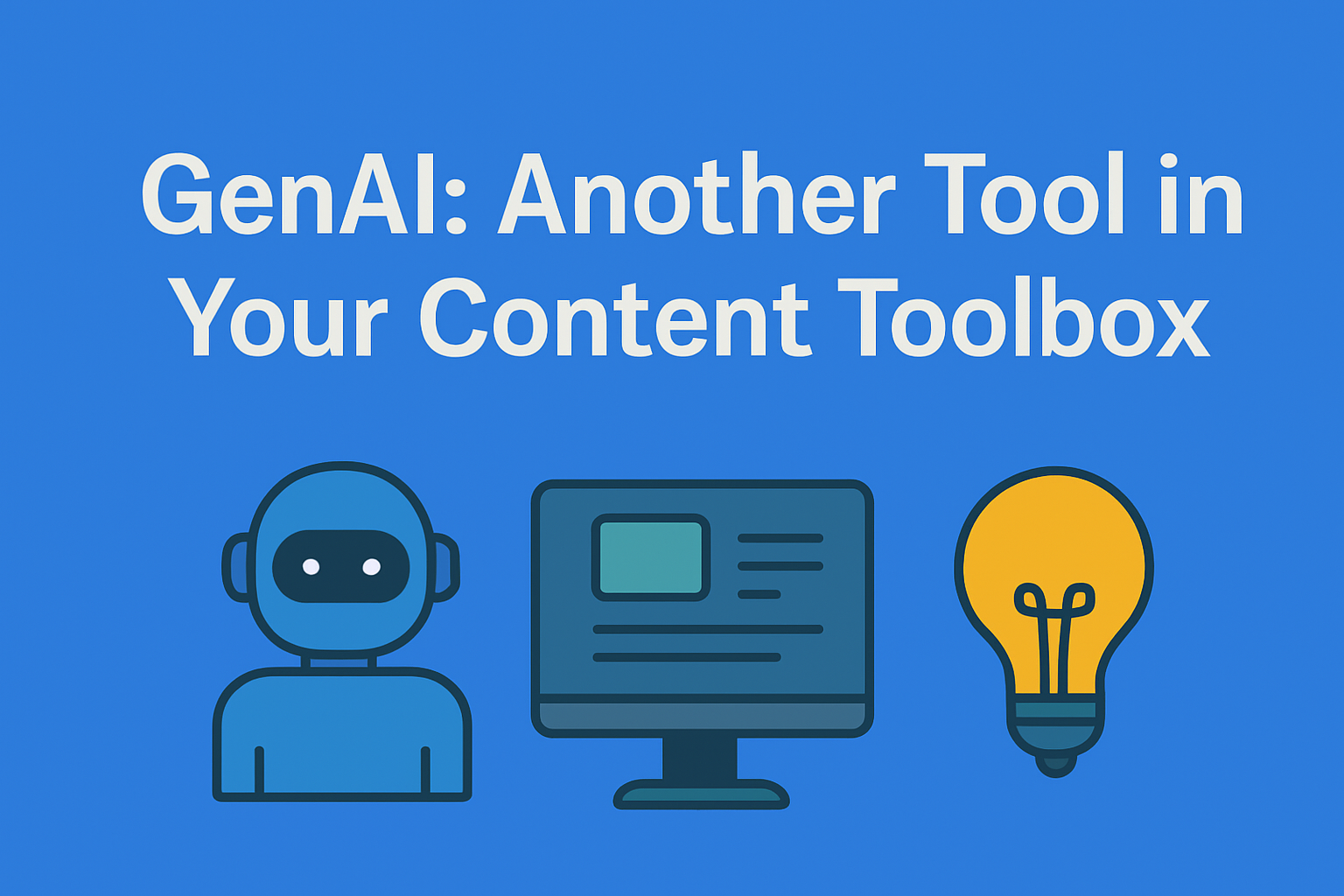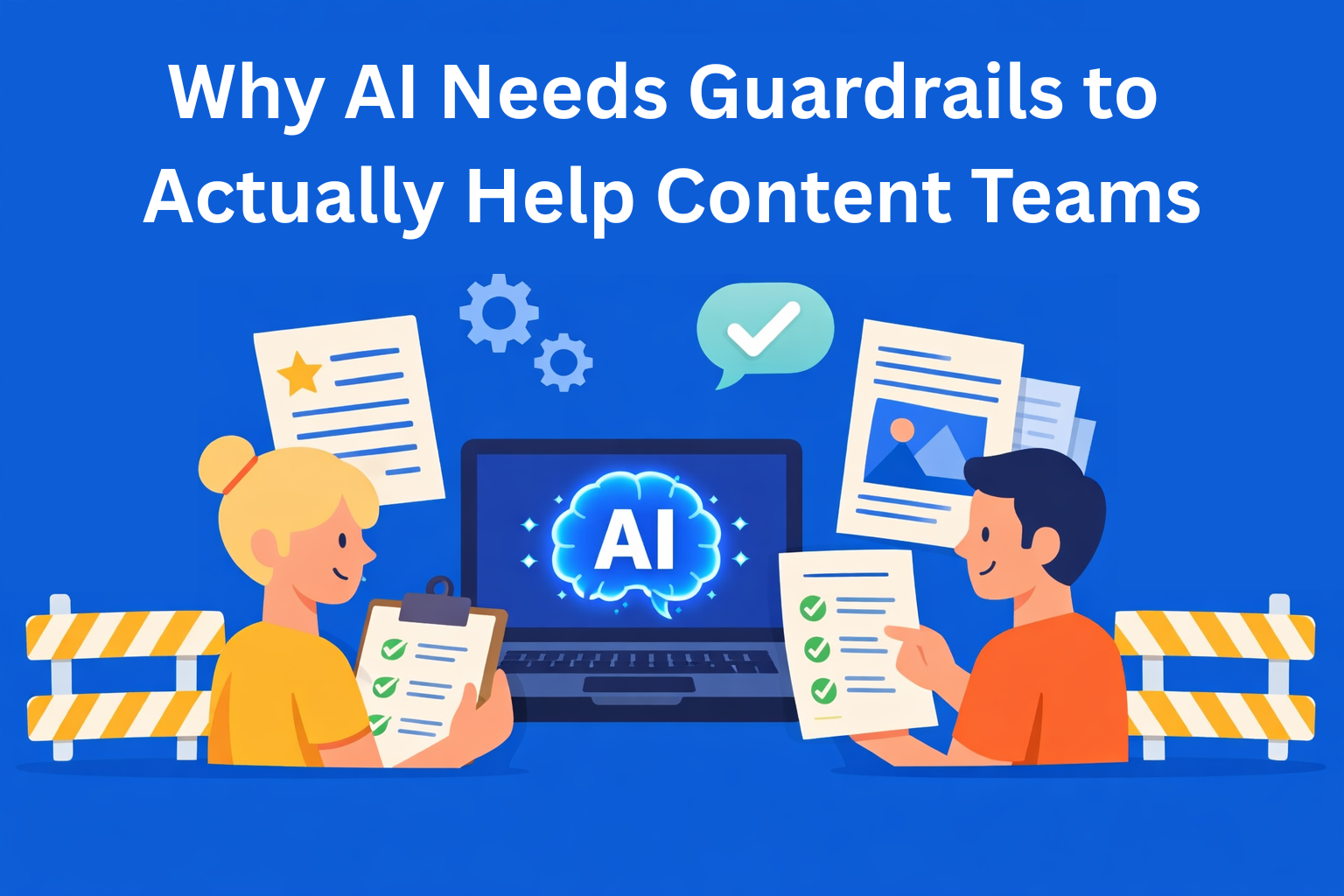GenAI: Another Tool in Your Content Toolbox
GenAI won’t replace your content team, but it can crush busywork. Learn how to use generative AI as your creative sidekick for faster workflows, better collaboration, and smarter automation - without losing control, quality, or your brand’s human touch.

The rise of generative AI is one of those moments that makes you pause, look up from your screen, and go, “Well, this changes things.” It’s like when the power drill showed up and the hammer had to come to terms with a new coworker. Generative AI isn’t magic, and it certainly isn’t a sentient writing machine, but it is undeniably useful.
Like any shiny new tool, its usefulness depends on who's using it. In the hands of a seasoned pro, it can cut hours of busywork, unlock new workflows, and give teams more time to focus on strategy. Used poorly, it’s just a digital mallet pounding out lifeless content.
Key Takeaways
- GenAI is a tool, not a teammate - It boosts productivity but still needs human creativity, direction, and judgment.
- It excels at automating repetition - Use it for summaries, variations, metadata, and research-heavy content prep.
- Editorial standards matter more than ever - Train your team to write better prompts and review outputs critically.
- Version control is essential - AI can flood your workflow with variations; manage them with a platform like EasyContent.
- Use GenAI to enhance collaboration - Let AI handle the busywork so your team can focus on nuance and originality.
- Quality beats speed - Just because AI can generate fast doesn’t mean you should publish everything it writes.
- Governance builds trust - Know what’s human-made vs. AI-assisted, and create clear approval processes.
- Asset reuse gets easier (but still needs review) - Let AI help adapt content for new formats, but always verify results.
- The future is human-guided AI - GenAI helps you build faster, but people still define the blueprint and tone.
Workflow automation
Is where GenAI begins to shine. It’s not about replacing writers; it’s about replacing repetitive processes. Summarizing meeting notes? Drafting ten versions of the same FAQ? Yeah, let the bot handle that while you do the real thinking.
But just like someone learning to use a circular saw for the first time (hopefully with all their fingers intact), learning to wield GenAI takes a bit of training. It’s not plug-and-play; it’s more like plug-and-practice. Your first drafts might be rough. Your prompts may sound like you’re talking to a 2005 chatbot. That’s part of the learning curve.
Content briefs
Can be one of the first places to integrate GenAI smartly. It can help structure outlines, suggest headlines, or even surface common SEO gaps. But, and it’s a big but, AI doesn’t know your brand, your nuance, or that inside joke from last year’s product launch that still makes your team laugh.
And that’s the thing. Tools are only as good as the craftsperson using them. The axe didn’t cut down the tree; the lumberjack did. The same goes for GenAI. It can suggest, assist, accelerate, but it can’t decide what matters. It can’t tell a story born from lived experience. It doesn’t know what your audience feels.
Version control
Becomes even more important when AI is involved. Suddenly, you’re dealing with multiple iterations of the same piece, generated at lightning speed. If you don’t have a clear system to manage drafts and track changes, you’ll end up lost in a sea of semi-useful content variations.
That’s why becoming a GenAI pro isn’t about treating it like a colleague. It’s about treating it like a high-powered extension of your brain. It’s your brainstorming buddy that never sleeps, your always-on research assistant. But it’s still your brain steering the ship.
Think of it like this: you wouldn’t hand a nail gun to someone who just learned what a wall is. Same logic applies here. Train your team. Create standards. Practice prompt writing. Evaluate outputs critically. And most importantly, use your editorial judgment. A good way to encapsulate all of this is with EasyContent. It can help you keep everything in one place while giving you a structured process along the way.
Metadata management
Is another quiet place where GenAI can shine. Writing titles, tags, alt text, or descriptions for a hundred pieces of content is a pain. Having a tool that can draft those quickly gives your team more time to optimize and refine.
And speaking of refining, let’s not forget that GenAI is also a great tool for editing. Want to rewrite a paragraph in a different tone? Ask it. Need to condense a wordy executive quote into something that sounds like a human being? Let it take a pass. Will it get it right the first time? Probably not. But it can get you started.
Collaboration
Actually improves with GenAI if used right. Instead of bogging teammates down with repetitive or research-heavy work, GenAI can jumpstart drafts or provide options to riff on. It frees people to focus on what humans are actually good at: nuance, context, and creativity.
But beware the trap of overproduction. Just because GenAI can generate 20 blog drafts in a minute doesn’t mean they are good. Quality beats quantity every time. Use it to scale smart, not to spam.
Editorial calendar
Tools that integrate GenAI are already helping content teams brainstorm themes, plan articles, and even recommend gaps in coverage. It’s like having a junior strategist who never takes lunch breaks (but also never quite gets the vibe without help).
So no, GenAI isn’t going to replace your team. Not now, not ever. Because your team isn’t just typing words into a box. They’re thinking. They’re researching. They’re adapting and reacting and creating resonance. A machine can mimic tone, but it can’t feel the audience.
Content governance
Becomes essential as these tools get folded into daily workflows. Who approves what? What’s the review process? What parts of the content are human-generated versus AI-assisted? These questions matter, not just for quality but for transparency.
In the end, GenAI is just another tool in a long line of inventions designed to make work a little faster, a little easier. It’s your digital chisel, your content crowbar, your idea-starter hammer. Use it wisely, and it’ll serve you well.
Just don’t let it pick the paint color for your brand voice.
Asset reuse
Becomes more dynamic when AI can help reformat content for different platforms. A long-form blog becomes a LinkedIn post, a tweet thread, a newsletter snippet. But again, someone needs to verify that it actually makes sense.
If you’re looking for a way to manage all this, AI drafts, human edits, multi-team workflows, and a dozen versions of “final_v4_ACTUALfinal” that’s where a platform like EasyContent can step in. It’s built for content teams juggling both speed and quality, making collaboration smoother, version control less chaotic, and content governance crystal clear. Because even the best tools need a solid workbench.
That being said, go ahead, add GenAI to your toolbox. Learn how it works. Try weird prompts. Give it the content equivalent of IKEA furniture and see what it builds. It might surprise you. Just remember: the future of content still needs humans holding the blueprints. And maybe a hard hat, just in case.






